Our Japan video is available for viewing on youtube. Enjoy!
Growing through Travel
Our Japan video is available for viewing on youtube. Enjoy!
Though we have now left Japan, there’s a few final notes of things we noticed while there that we thought was worth mentioning.
Overall, I think Japan is going to be very different from the other places coming up on our journey. We’ve already noticed a huge difference just coming to Singapore, and I’m sure by the time we get to Bangkok it will be the polar opposite. We really enjoyed Japan and were very impressed with the Japanese society as a whole.
In Japan, when you choose something as your profession, you dedicate your life to perfecting it. Whether it be knife making, sumo wrestling or noodle making. To become Sushi Itamae (high chef) you first have to work for 5 years under a master before you can even prepare the sushi rice. You have to prepare the rice perfectly daily before you can be promoted to Wakita (near the cutting board) where you slice ginger, scallions etc. for a few more years before becoming a senior apprentice ( can cut anything) to a full blown Itamae. This process can take up to 20 years. The same is true of Japanese noodle making. Chefs take years learning how to prepare, and often specialize in one type of noodle ( ramen, soba, udon).
Although it is not seen in every restaurant, the chefs definitely take great pride in their products and take it personally if you do not enjoy your meal.
In Takayama, we went to a “Japanese Pub” where the sole bartender created cocktails with such flair that we ended up getting more and more cocktails just to see him work. He created drinks tailored to what we liked, concocting mixes that were highly unusual, but worked! Homemade flavourings like shitake mushroom and Japanese tree bark, Japanese plum, and fresh ginger were some of his ingredients, combined with local sake (rice wine) and whiskey.
One of our staples on this trip has been ramen. A cheap, filling, and delicious bowl of noodles in a broth of your choice ( miso, soy sauce, pork) with slices of pork and onions and bamboo shoots topped with an egg and some seaweed. Think Mr. Noodles on steroids.
Udon is a thick white noodle that can be served on it’s own, or in a soup like dish similar to ramen.
Sushi is, of course, a must try in Japan. There are fresh fish markets open daily in every major city. The prices for sushi can vary dramatically, depending on the type of fish, what part of the body it’s from, and how fatty it is ( that fattier, the better). We went to a conveyor belt sushi restaurant, where the chefs are in the middle, and the customers sit in a big circle around them. 1 or 2 slices of sushi are put on a plate and then put on the belt. If you see something you like then you grab it when it comes your way and at the end of the meal all of your plates are counted up to tabulate your bill. Most of the local people there had about 5 plates each. Mark and I ate 20.
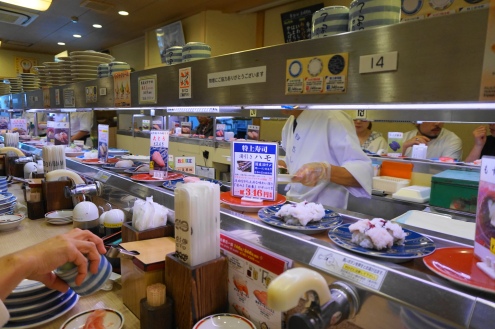
Bento Boxes are “train food”, and are sold in many train or bus stops for you to eat in transit. Filled with various substances and eaten cold, they are very bright, colourful, and pretty disgusting (the exotic ones).
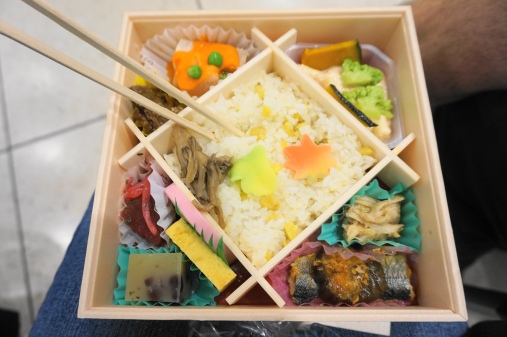
Okonnmiyaki is a Japanese pancake filled with cabbage and whatever else your heart (or the old lady cooking it) desires. Typically filled with onions, mushrooms, cabbage and some sort of meat or seafood, it’s pan fried, covered in a sweet brown BBQ like sauce and served on it’s own little stove top. You eat the food from the stove top and this way it stays warm as you chat away the evening.
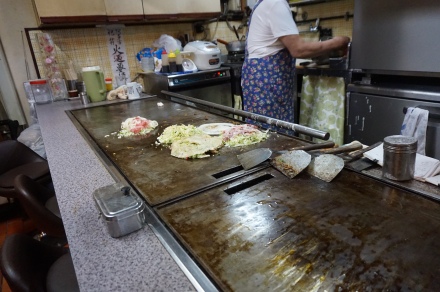
Tempura is veggies, seafood or meat dunked in a light batter and then deep fried. The light and flaky batter melts in your mouth, or when served in a soup flakes off and flavours the soup.
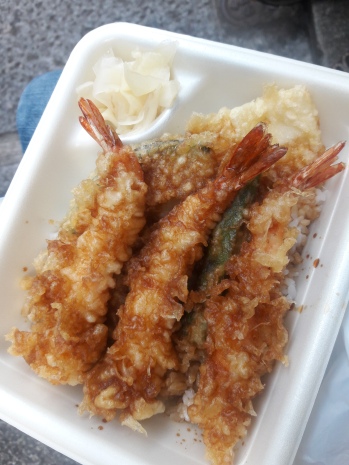
Gyoza are dumplings originally from China, but have become very popular across Japan. They are filled with beef, pork or vegetables and then boiled and pan fried.
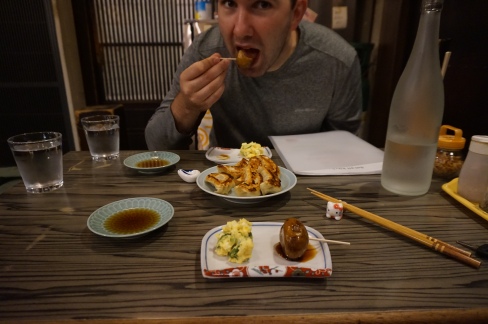
Tonkatsu is a Japanese breaded pork cutlet, deep fried and served with rice and usually some sort of curry like sauce and cabbage. It’s very tasty, and kind of tastes like a big chicken nugget.
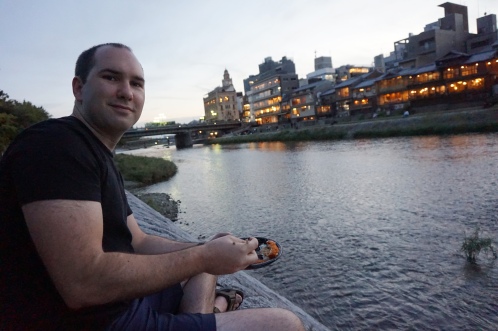
Yakatori is grilled meat on skewers, typically made up of different parts of a chicken. We unaware of this when we decided to try a Yakatori restaurant. We chose some items based off of the menu’s pictures. Being starving after a long day of walking, we were ready to devour it when the items came. It came and it looked delicious. One bite in…. chicken liver! Blast it all! Okay, so we won’t eat that. The next round came – more chicken livers but in a different sauce! Then came the chicken skin and shortly after, the chicken butts. And then more butts, and more butts. There was a glitch in their system that made them keep bringing us chicken butts! Mark liked these (blissfully unaware of what they were). With plates piled high and Mark looking plump and greasy, an American at our neighboring table chimed in. He had heard us discussing our liver predicament and made some recommendations for what to choose to get actual meat.
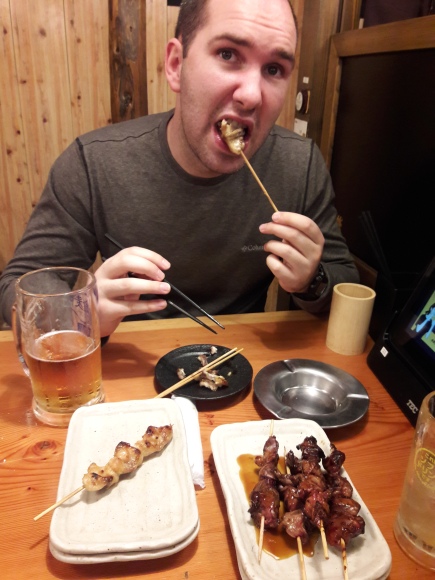
Tea is a big part of Japanese culture and they especially love Green tea. The green tea flavouring can be found in many foods, including ice cream! When walking in a garden in Kanazawa, it started to pour rain and we escaped by going into a tea house for some traditional tea. The green tea was thicker than we expected and tasted a little bit like grass. It was served with Mochi, a sweet rice that’s pounded into a ball and filled with red bean paste. It tastes sort of like uncooked dough, but somehow it works with the grass juice.
All in all, Japan has some very interesting tastes, and for sure has some of the best chefs in the world in their classes. We’ve ticked some items off our food bucket list and are now ready to hit up the flavours of the next country- but we will probably get one more bowl of ramen before we go.
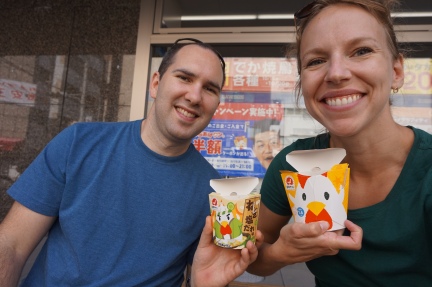
Subscribing or following our blog will ensure you’re notified when we publish new content. Don’t miss any of our riveting content!
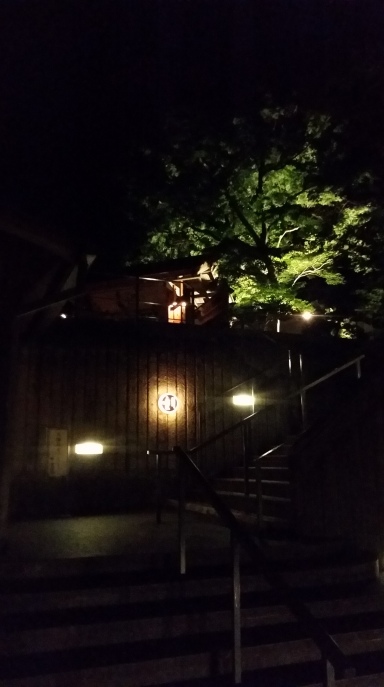
Japan is a volcanic island with soaring mountains and many hot springs. Over the centuries, bathing in hot springs has become a part of their culture. It is ritualistic and, as with all things Japanese, methodical. An onsen was originally a hot spring where one would bathe but has now come to mean the entire spa that is built around a hot spring. It is truly a delightful and relaxing experience. Men and women are segregated and the whole ordeal is done fully nude. This is mildly uncomfortable but somehow seems very normal once you partake. You have a small towel to cover your private bits when walking around and you must shower thoroughly before entering the pools. There are no pictures allowed (kinda kills the zen feel when people are photographing your junk) but we’ve found some online that look similar to what we experienced. onsens do not allow patrons with tattoos. This is to prevent Yakuza (Japanese mafia) from congregating (Yakuza are heavily tattooed in areas that can be covered by clothing). I have a tattoo on my lower leg so we searched for an onsen that would accommodate us. We were staying in the Hakone region of Japan which is known for Mount Fuji and onsens. Luckily we found one and it had very good reviews – fantastic!
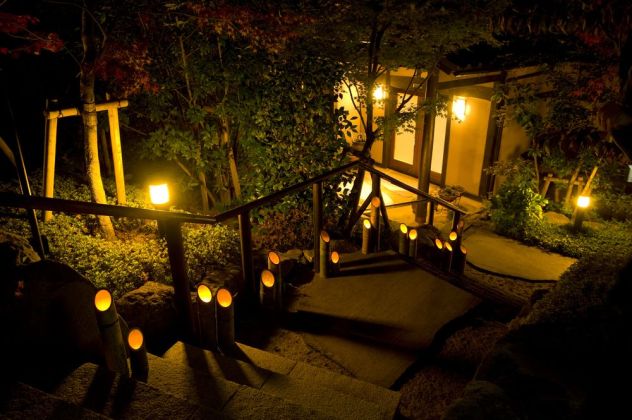
The atmosphere is very comforting; whispering voices, trickling water, dimmed lights, beautiful woodwork and paper windows; wonderfully Japanese. You strip down and then thoroughly wash yourself. An elderly Japanese cleaner noticed me (I stuck out like a sore thumb) immediately and lead me to the showers. The showering area is beautiful with stonework and gorgeous wood. It’s steamy and smells like cedar and exotic soap. You squat on a stone and begin to bathe. With my confidence growing I reached for a bar of soap – thinking it was communal – I began lathering. Mid lather, I realized I had taken my neighbor’s bar of soap and he seemed to be sporting a full body tattoo. It was at this point that I realized, of all the centuries of etiquette I managed to desecrate so far, borrowing a Yakuza’s soap must take the cake. He glanced at me and I bowed as best I could and placed the bar back down.
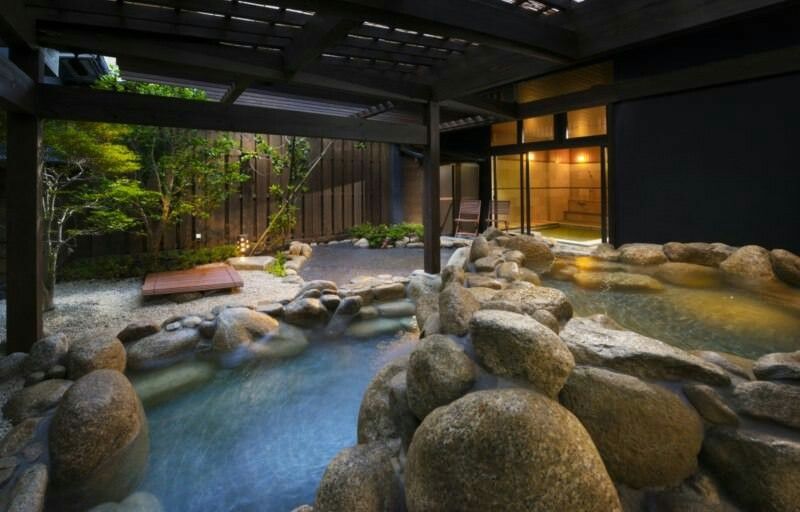
There are multiple pools ranging in temperature and elevation. The pools are outdoors amongst immaculate Japanese shrubbery and trickling water falls. The air is cool and crisp and steam is rising from the pools. With your towel soaked in cold water and placed on your head, you slip into a pool of your choosing (or clumsily stumble and almost fall onto an elderly man – without question I was a negative zen contributor). When you feel like a cooked lobster, you plunge into the cold pool. The process leaves you feeling relaxed and revitalized. As you become more comfortable, you begin to appreciate what you are experiencing: Centuries of tradition and a spiritual feeling that the Japanese take very seriously. They crave the onsen to help balance their stressful lives. The nakedness melts away the hierarchical structures that are rigid and cold. We all need something like this.
Subscribing or following our blog will ensure you’re notified when we publish new material. Don’t miss any of our riveting content!
The Way of the Samurai sounds like what your nerdy friend pretended to be back in high school. Well, that guy was onto something that has spanned close to a millennium and remains a way of life in Japan. Awesome armour, unwavering discipline, and the best swords in the world; this is Samurai. It’s a lot more complicated than that but I just like finishing sentences with – this is Samurai.
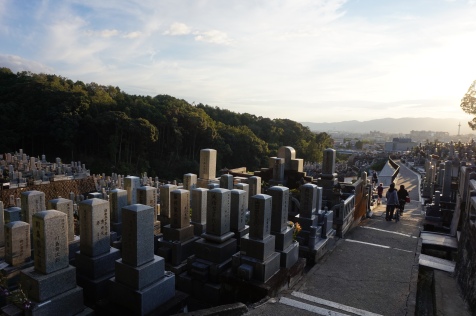
The Samurai arose around ~1000 AD and were originally thugs. Masterful swordsman who would represent clans and impose their will on others. Eventually the unification of Japan took place and a feudal system was put in order. The Samurai were in the ruling class just below the Emperor. Skilled workers (engineers, etc.) were second on the pyramid and the peasants held the lowest of the social order. This system lasted for around 700 years and forever infused the Way of the Samurai into Japan. Bushido is the code that governed the Samurai; it has 8 core values: Rectitude, Courage, Benevolence, Politeness, Sincerity, Honor, Loyalty, and Self-control. A Samurai would commit his life to pursuing and harnessing these principles. It can’t be overstated how serious this was to a Samurai. Bringing dishonour on himself could only be cleansed by Seppuku, suicide by disembowelment.
During Japan’s modernization, the Samurai lost their political power and status. There were bloody revolts (this is a theme through Japanese history) but ultimately technological advancement triumphed and the Samurai as a class, were no more. Japan entered into a hyper-advancement era that continued into a ultra militaristic period. The intensity of the Samurai never disappeared; it lay beneath the surface and was stoked during WWII. The Japanese forces were some of the most ferocious enemies one could encounter. If military success is contingent upon discipline and obedience then the Japanese were ripe for a monumental military.
The vestiges of Samurai can still be clearly seen in Japan. Though Japan is not allowed to have a fully sized military, the average citizen displays an adherence to Bushido that would spin a Westerner’s head. There have been times when I’ve thought to myself “Stop bowing to me already, you’re making me uncomfortable. I can’t take all this respect! I need someone to yell at me.”
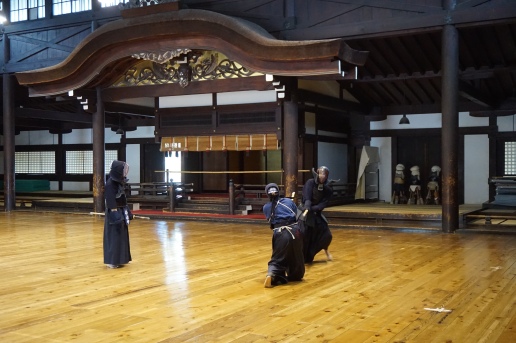
Enter Kendo – a sword fighting sport that teaches the core values of Bushido. It is a commonly practiced sport among Japanese and is taught at an early age. It is extremely methodical and disciplined. You’re taught to battle with your opponent but to always give respect. In the early days of Kendo, certain matches would be held with no armour and real swords (and you thought hockey was hardcore). The same gravity is displayed when you enter into a match in today’s age even though you’re wearing body armour and using a bamboo stick (I pictured it as real).
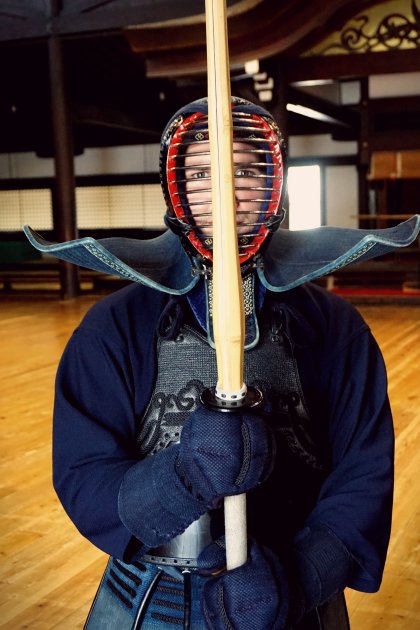
Now that I have sufficiently prefaced Kendo, I can brag about the incredible opportunity I had. I trained with Tomoyoshi Yamanaka. He is a 4th generation descendant of a Samurai who guarded one of Kyoto’s castles. I was fortunate enough to spar with him ( I think I put up a good fight but Alayna begs to differ) and receive a lecture on his life and what it means to be samurai. The dojo I trained in was particularly beautiful because it was designed for the emperor to watch matches.
I’ve donned the armour. I’ve swung the sword. I am Samurai.
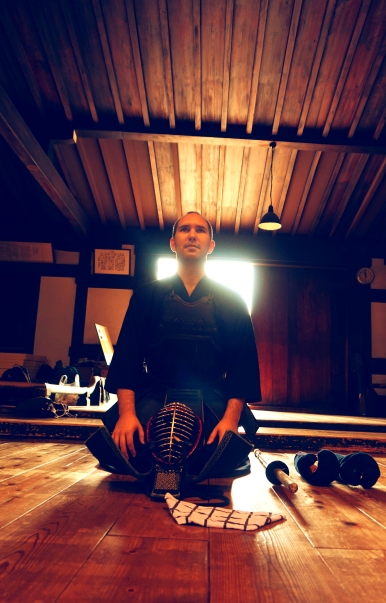
If Tokyo runs like a well oiled machine, than Kyoto is that old classic car that causes you some headaches, but you like because it’s pretty.
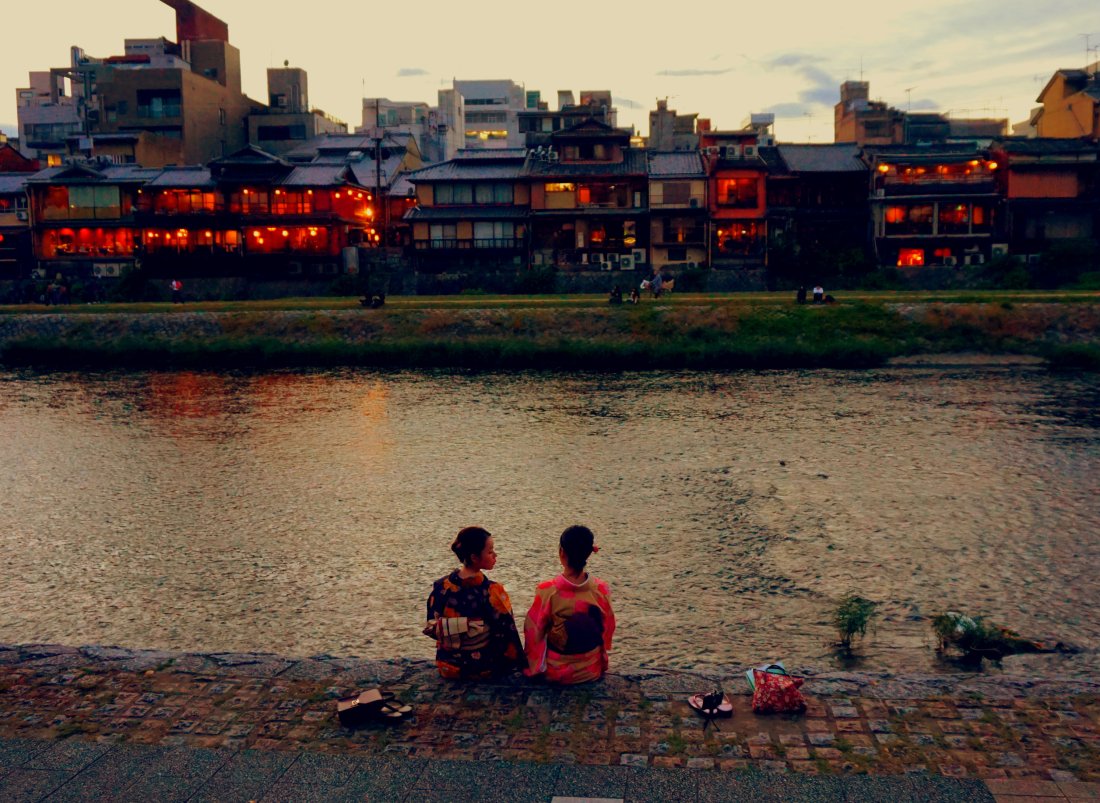
The first thing you notice when you arrive at Kyoto station ( after riding on your high speed Shinkansen at 320 km/hr) is that you are no longer among the locals going about their days, but rather one of the hoards of tourists shuffling about confused. The order and cleanliness of Tokyo is out the window, and my blonde hair no longer stands out.
Kyoto used to be the capital of Japan for more than 1000 years and the emperor’s main palace is located here. It was spared from the atomic bombs in WWII at the last second ( 2 weeks before) due to it’s cultural importance, with more than 2,000 Buddhist temples and Shinto shrines including 17 World Heritage Sites.
It’s easy to see the beauty of this place, with large temples, shrines and palaces almost everywhere you go. To me, it’s similar to Rome, you turn a corner and there’s some beautiful ancient structure next to a convenience store. So, you can expect with such history, beauty and cultural significance that people want to come and see it- and boy do they. Hundreds of tourists at every spot, shoulder to shoulder with some lady yelling “ RICK! HERE! GET A PICTURE OF ME!” kind of takes away some of the elegance and atmosphere. Luckily, tourists are predictable and don’t like to get up early. This means that we do. 5:45 rolls around and we’re up and at ‘em leaving our hostels by 6:30 and making our way to the sites. By the time we’re done exploring, the tour bus groups are there and we can quietly sneak out. This obviously doesn’t work for all places, but we pick and chose where we want to see the most and go there early.
For example: Fushimi Inari-taisha. This is a Buddhist temple and Shrine dedicated to the God Inari- God
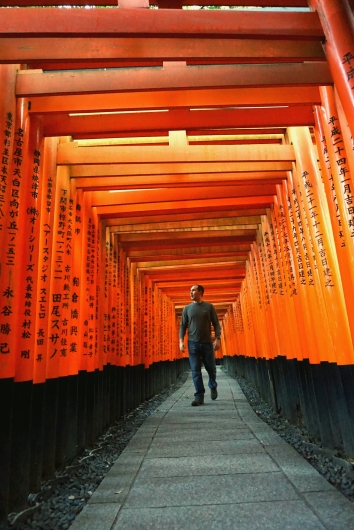
of rice. Though the temple itself is nice, the real draw are the thousands of torii ( traditional Japanese gates) that line a path up to the top of the mountain.
Carved into the gates are people’s names who have donated and the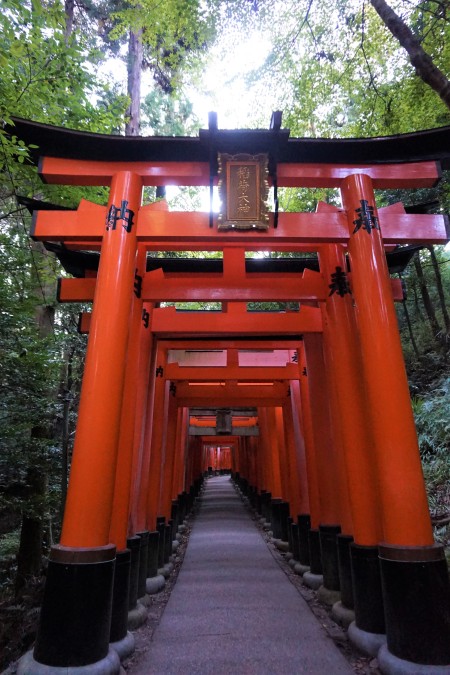 date of donation. There are said to be over 10,000 torii gates, and I believe it. The 5km path to the summit of Mount Inari has very few places where you are not walking through these gates. It’s very peaceful climbing up the mountain with the sun rising and slowly bringing the vibrant orange of these gates to life.
date of donation. There are said to be over 10,000 torii gates, and I believe it. The 5km path to the summit of Mount Inari has very few places where you are not walking through these gates. It’s very peaceful climbing up the mountain with the sun rising and slowly bringing the vibrant orange of these gates to life.
Kyoto is also said to be one of the best cities in Asia for bicycling. Not liking the idea of having to rely on buses, we rented some ( which was a bit of an ordeal itself). It’s quite nice to be able to easily go from neighbourhood to neighbourhood, seeing things quickly and that we might not otherwise see. We’ve gone about 40 km in the last 2 days. The negative is bike parking! Never have I been more frustrated with biking. Kyoto has VERY strict rules about where you can park your bike (essentially no where) and very few parking spots- which are not well marked. The easy breeze of getting somewhere on your bike is taken away by the 30 min it takes to find a parking lot to go get some lunch. We’re getting better at finding them, but Kyoto- you need to up your parking game.
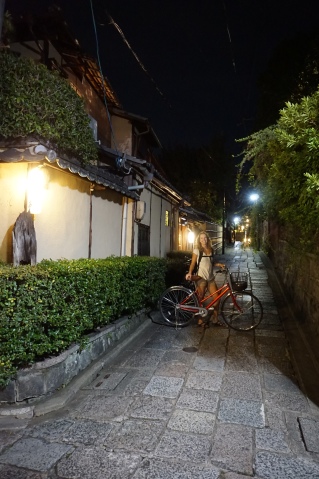
All in all, Kyoto has many beautiful things to offer, but we’re ready to hit the next bullet train out of here and go to somewhere where we don’t fit in.
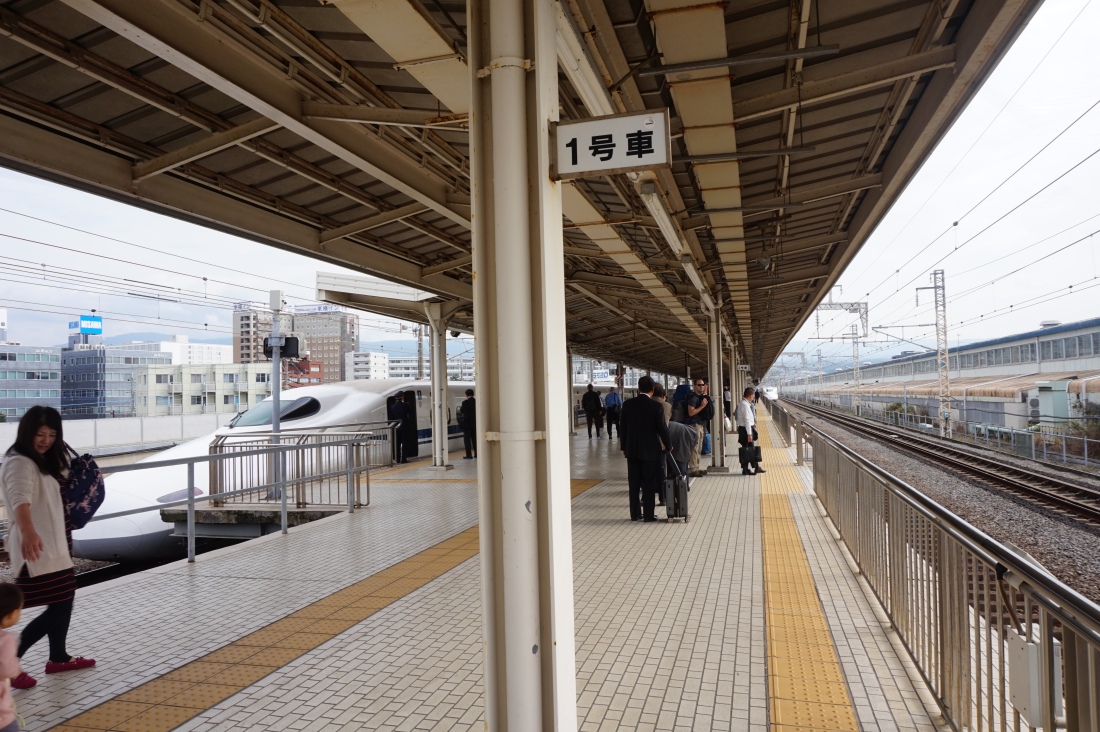
Subscribing or following our blog will ensure you’re notified when we publish new content. Don’t miss any of our riveting content!
Japan is an ancient Empire transcending millennium. Through much of its history it has been isolationist due to geography or political will. This has shaped the Japanese people in very pivotal ways. Their culture is steeped in honor and tradition; it is unacceptable to bring dishonor upon yourself or family. Being polite and respectful is of paramount importance. You are less an individual as you are a single iteration of a long bloodline. This concept is foreign to Westerners as our culture and philosophy deem us as individuals before anything else. Their cohesive bond ties the Japanese people together and has helped with their cultural longevity. 127 million people harmoniously living on an island 26 times smaller than Canada is quite the feat, this I can assure you; courtesy goes a long way.
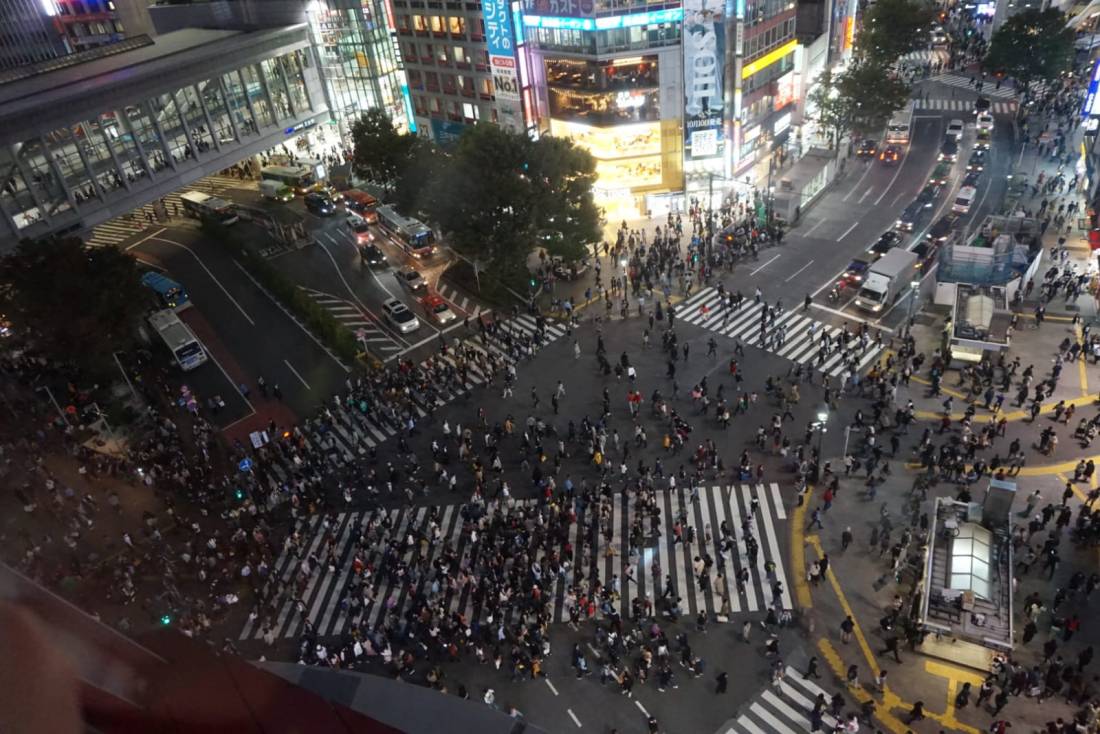
For every reaction there is an equal and opposite reaction – or whatever Newton said, right? Que crazy, bizarre, Tokyo. All that repression had to manifest itself somewhere – and it did. Tokyo’s got pockets of crazy emerging out of the methodical machine that makes it so unique. Quasi-sexy, anime, Victorian era, maids that clean your ears, compliment cafes where one pays to have cartoonish complimentors boost your ego (this is something the West should look into). Mario kart dress up and driving through the streets of Tokyo (I actually see the merit in this one too). Occupational sudden mortality Karōshi (過労死) or working yourself to death. You get the idea – there’s some wonky stuff in this city.
The juxtaposition of these two concepts couldn’t be more stark. No homeless or deranged people (this strikes you immediately if you come from a North American city – on second thought, maybe it’s best not to ask what their solution is..) but some of the strangest erotica in the world. Preserving honour and respecting the elderly but intertwining sexuality and cuteness.
Despite the oddities and extremes, Tokyo is my favourite city I’ve ever travelled to. It’s extremely livable. The air quality and transportation systems are fantastic. There is ample green space with immaculate gardens. The city is noticeably quieter than any other city I’ve been to (no honking, electric cars, very little traffic, etc.). The prices are very reasonable compared to other major cities, New York, London, etc. (finding a 10CAD lunch is easy to do). World class venues, restaurants, bars, experiences, and some of the most well mannered and polite people I have ever interacted with.
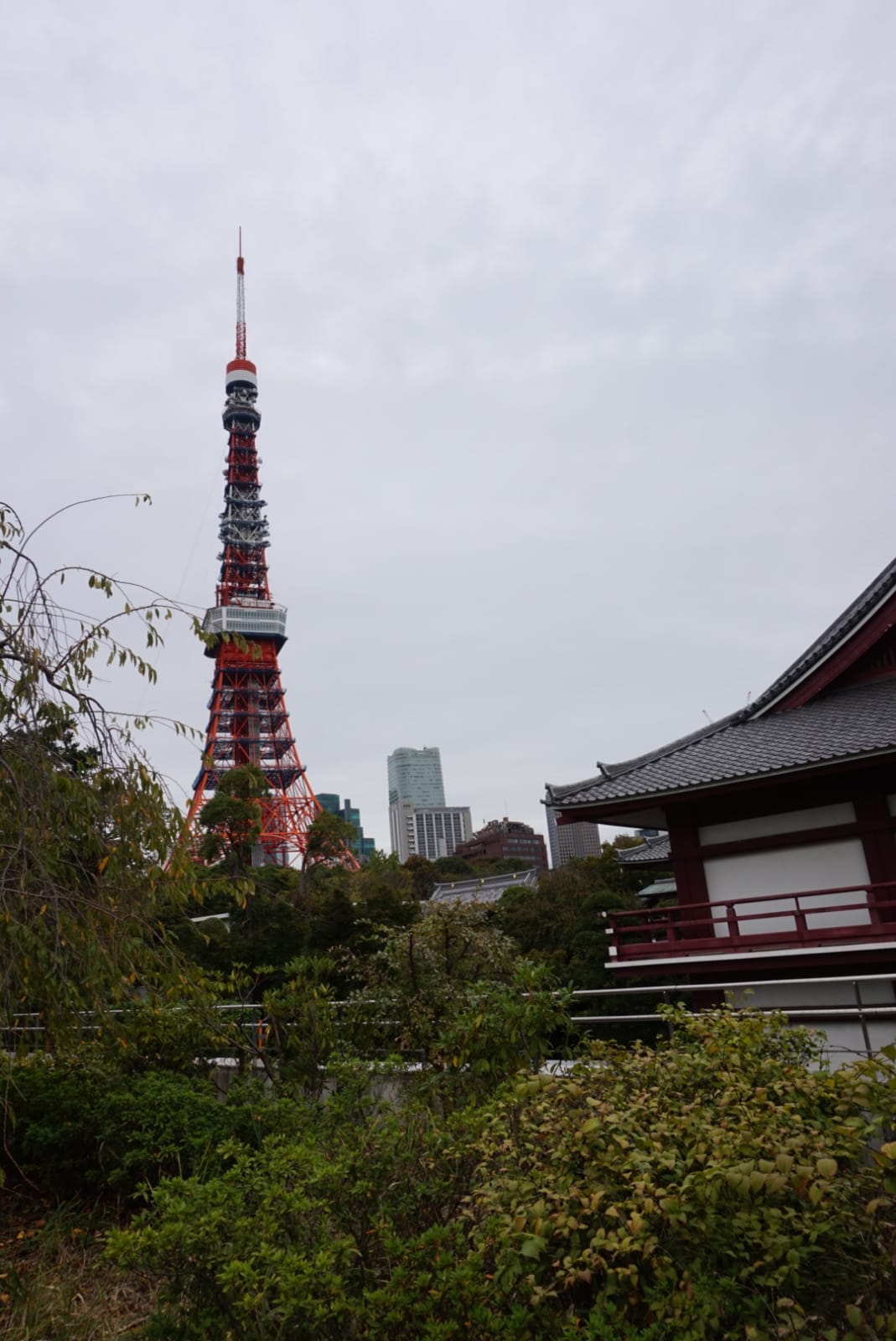
Seeing 300lb men in thongs is not something the average person wants to see but when in Japan, it’s a must do. We were lucky enough to find a sumo stable to watch professional sumo wrestlers have their morning practice session before having one their 10,000 calorie lunch ( they consume 20,000 per day- that’s 10x a normal person).
There were sumo wrestlers inside, where they would stretch and take turns trying to push each other outside of the ring on the ground made out of sand. Outside, others cooled down after their turns, warmed up for the next turn and mended their aching parts with ice and bandages.
Mark told me to go and ask to take a picture with them. Sure- send the measly girl to the huge wrestler- that’s not intimidating… So I worked up the courage and asked, but he gave a shake of the head no and I wasn’t about to try and argue with him.
After the sumo stable we went to the Tsujki Fish Market and had some fresh sushi. It definitley was the best I had ever had and there is a noticable difference between the fish here and what you can get back home.
We ordered sampler type plates, with a little bit of many things, not really looking at what was on or in each one. More of a “just try it and don’t think about it” approach. So I grabbed one and plopped it in my mouth- it was the weirdest texture I had ever experienced; it was like a moist, soft, jello that just gushed around. The nausea came quick and I just gulped it down and prayed it wouldn’t come back up (it didn’t). Turns out it was sea urchin. I do not recommend. The rest of the sushi/sashimi was fine, with textures ranging from “melt in your mouth” fish ( it really does melt- it’s weird) to very chewy. An authentic experience that was adventurous, delicious and very filling.
After months of planning and over 24 hours of travel, we finally arrived at Narita airport. Feeling grubby and exhausted we navigated our way to our accommodation and promptly crashed.
Tokyo confirms the stereotypes that we all know of Japan: cleanliness, meticulousness, discipline, etc. The organized manner in which the city operates is astounding. People are walking everywhere and they all know where to go and the most efficient way of getting there. You won’t see wasteful head-checking when crossing a street or hear loud conversations – everything glides seamlessly and quietly like an orchestrated simulation. There really is a harmony to how the city functions. It’s refreshing because the frustrations that we’ve all experienced – the obnoxious idiot talking on his cellphone in the subway, the smoker who flicks their butt onto the sidewalk, the cabby who decides to do a u-turn in rush hour and blocks both lanes of traffic – they can’t be found here. The environment will affect you immediately; you’ll find yourself sitting on the train with slightly better posture and gesturing a bow when you queue incorrectly for your designated train car. Somehow the system works too well for you to let it down.
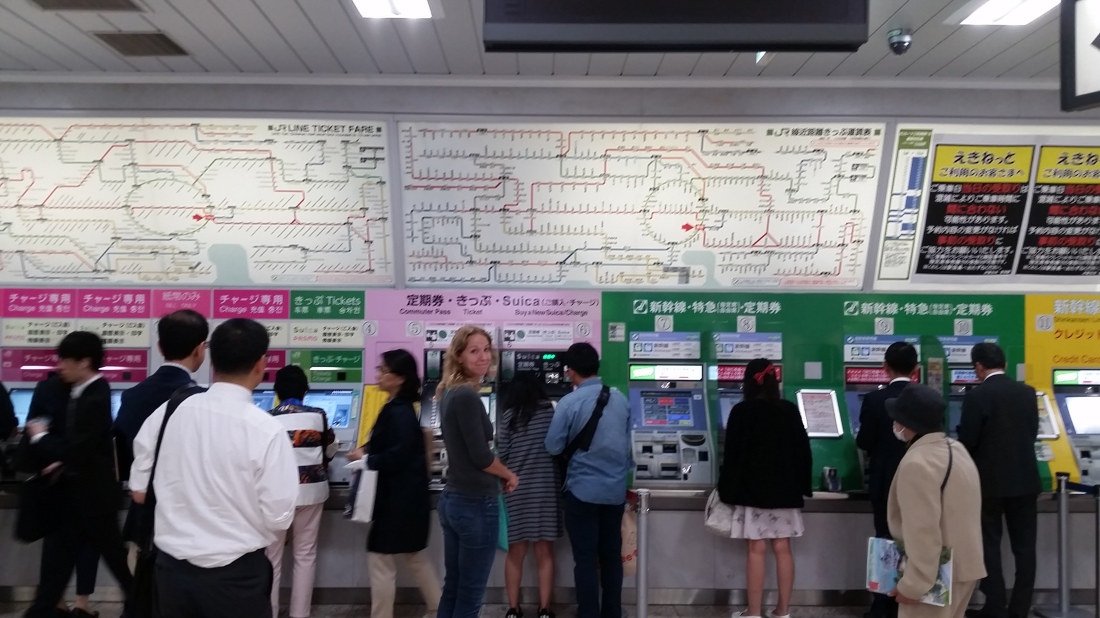
The Tokyo subway system is the busiest in the world. Take 50 TTC systems and plop them on top of each other. Subtract the dirtiness, homelessness, scariness, and delays and you have the Tokyo subway system. Despite the system being extremely intuitive, you may find yourself the only male on a female-only train car (I was wondering why so many women were staring at me), or being ushered around by one of the dozens of “traffic force” – think white gloves, robocop helmet, red wand, and microphone for emphasizing Japanese command words – when you inevitably do something wrong.
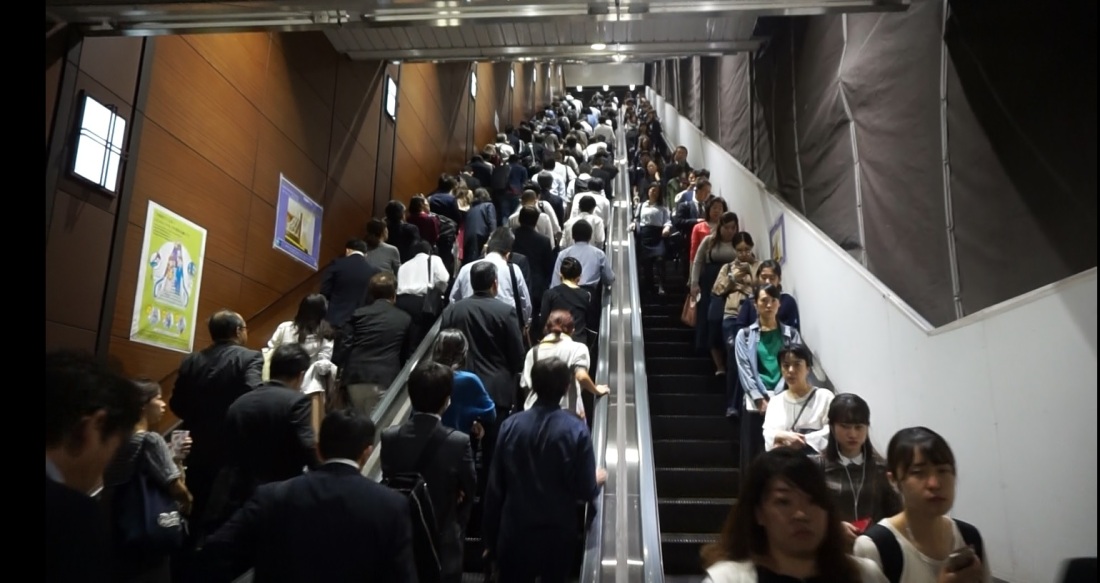
You’ll gawk at the directional arrows posted everywhere and detailed signage, thinking: “this seems a bit excessive” but just wait until 7:30am arrives and the tsunami of suits flood into the subway. The entry ticket machines chime like the floor of a casino but you won’t hear a single word spoken. As you glide along in your particular stream, it all begins to make sense. Poor Alayna was courageous enough to leap out of her spot in our stream to take a picture and couldn’t find a way back in. I drifted away as she sat in an eddy current waiting in vain to rejoin the river. This thing is bigger than us – just go with it.
Follow your arrows and you’ll survive!